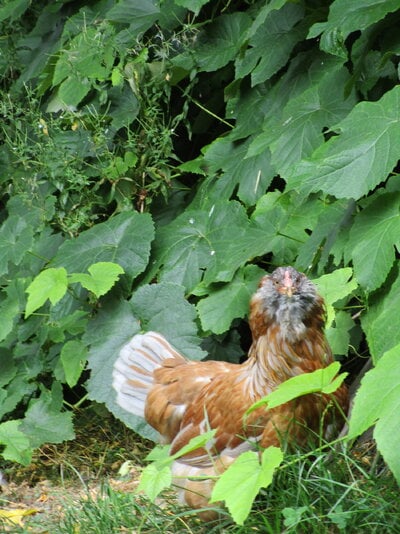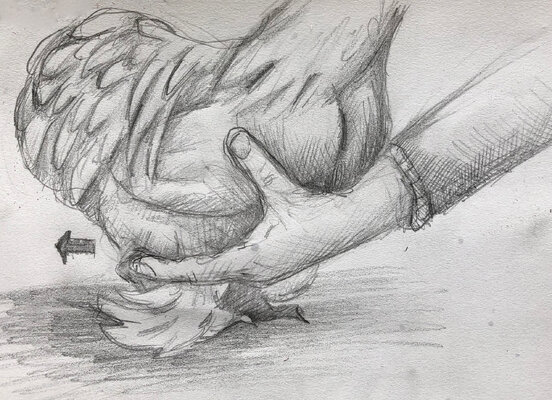Showmanship is a fun way to enjoy your chickens and expand your chicken knowledge. It lets exhibitors show off their chicken handling skills and compete for ribbons and other prizes. Chickens that are not exemplary examples of their breed’s type can compete and win in showmanship. But without practice, handling the chicken can become quite difficult. Forming a bond with your chicken through training can make chicken handling easier.
Showmanship is a class commonly held at poultry shows, usually for youth exhibitors. Some shows have classes for all ages. Exhibitors are asked to stand their chickens on a table while a judge tests their poultry knowledge through a series of questions. Participants also given points for the cleanliness and behavior of their chickens and handling the chickens correctly.
The temperament of a showmanship chicken matters more than correct breed type. Ideally, the chicken should be a standard breed recognized by the American Poultry Association’s Standard of Perfection. Bantams are generally best due to their trainable natures and small size. Standard-sized chickens can be heavier and harder to pick up and hold correctly.
Some popular breeds include:
Showmanship is a place to show off your chicken knowledge! The judge can ask almost any poultry-related question. The questions are usually not just about chickens--they can be about turkeys, ducks, and other types of fowl. However, some common question topics include:
Practice Quiz:
Supplies needed:
Repeat training in short sessions. Reward good behavior. Don’t overdo the treats!
The most important part of showmanship is posing your chicken. This is done on the table. Hens or pullets face to your right, and cockerels or roosters face to your left.
Steps:



It is also important to know how to pick up your chicken for showmanship. Steps:

Showing the feet:
Showing the head:

Showing the width of the back (a measure of laying capability):
“Checking for mites”: Most shows have a vet check, so you will already know if your chicken has mites or not! Chickens must be mite-free to show. This is just a way to show that you know how to check for parasites.
Steps:


Alternate way to show the keel (no turning the chicken upside-down):

Showmanship Attire
Some shows have special rules for what the exhibitor should wear. Standard attire is a white long-sleeve shirt and black shoes and pants.
Some shows also require “walking the chicken.” This is not covered here.
Altogether, it’s more pleasant to handle a well-trained chicken than one that's flapping all over the place.
Quiz answers:
What Is Showmanship?
Showmanship is a class commonly held at poultry shows, usually for youth exhibitors. Some shows have classes for all ages. Exhibitors are asked to stand their chickens on a table while a judge tests their poultry knowledge through a series of questions. Participants also given points for the cleanliness and behavior of their chickens and handling the chickens correctly.
Choosing a Chicken for Showmanship

The temperament of a showmanship chicken matters more than correct breed type. Ideally, the chicken should be a standard breed recognized by the American Poultry Association’s Standard of Perfection. Bantams are generally best due to their trainable natures and small size. Standard-sized chickens can be heavier and harder to pick up and hold correctly.
Some popular breeds include:
- Bantam Cochins
- Silkies
- Old English Game Bantams
- Modern Game Bantams
- Rhode Island Red Bantams
- And many more!
Knowledge for Showmanship
Showmanship is a place to show off your chicken knowledge! The judge can ask almost any poultry-related question. The questions are usually not just about chickens--they can be about turkeys, ducks, and other types of fowl. However, some common question topics include:
- Anything from the APA’s Standard of Perfection book (if you live in the USA). This focuses mostly on breeds, classes of chicken, poultry terminology, show disqualifications and defects, and types of plumage and combs.
- Diseases and their cures.
- Parasites.
- Egg incubation times and incubation terminology.
- The Bleaching Order.
- Chicken bathing and show preparation.
Practice Quiz:
- What is the incubation time of a chicken egg?
- How many breeds of turkey are there?
- True or false: “Faking” is a disqualification.
- Name two types of comb.
Training Your Chicken
Supplies needed:
- Treats for your chicken, broken into small pieces. Treats can include mealworms and scratch grains.
- A chicken.
- A non-slippery table that can get dirty.
- An area where it’s OK if the chicken flies off or gets away.
Repeat training in short sessions. Reward good behavior. Don’t overdo the treats!
The most important part of showmanship is posing your chicken. This is done on the table. Hens or pullets face to your right, and cockerels or roosters face to your left.
Steps:
- Set your chicken on the table, facing in the correct direction. Set one hand gently on the chicken’s back and the other in front of its chest. Try to get the chicken to stand quietly for a few seconds. Try to gradually increase the time your chicken stands quietly. Only reward good behavior.
- When the chicken stands quietly, try to get him or her to stand still without being held. Encourage the chicken to pose according to the breed standard (see the drawings in the Standard of Perfection as a reference).
It is also important to know how to pick up your chicken for showmanship. Steps:
- Pose the chicken on the table.
- Slide one hand underneath from the front so your two middle fingers are between the chicken’s legs.
- Gently but firmly close your hand and place the other hand gently on the chicken’s back.
- Pick up the chicken.
- Pick up the chicken.
- Take your hand off the chicken’s back and use it to gently spread the wing.
- Gently let the wing slide back into position.
- Set the chicken down.
- Pose the chicken.
Showing the feet:
- Pose the chicken on the table.
- Pick up the chicken.
- Take your hand off the chicken’s back.
- Gently move each foot back and forth, using your free hand.
- Set down the chicken.
- Pose the chicken again.
Showing the head:
- Pick up the chicken.
- Take your free hand off the chicken’s back.
- Move the hand holding the chicken up with the chicken’s head facing forward and away from you.
- Set the chicken down.
- Pose the chicken.
- Pick up the chicken.
- Take your hand off the chicken’s back.
- Gently pet the feathers on its back the wrong way.
- Wait a few seconds.
- Set the chicken down.
Showing the width of the back (a measure of laying capability):
- Pick up the chicken.
- Take your hand off the chicken’s back.
- Put your hand across the widest part of the back.
- Gently put your thumb and forefinger on each side.
- Wait a few seconds.
- Set the chicken down.
“Checking for mites”: Most shows have a vet check, so you will already know if your chicken has mites or not! Chickens must be mite-free to show. This is just a way to show that you know how to check for parasites.
Steps:
- Pick up the chicken.
- Take your hand off the chicken’s back.
- Ruffle the feathers on the back of the neck, look under a wing (see “showing the wing”), and under the tail. Optional: check legs for scaly leg mites.
- Set the chicken down.
- Pose the chicken.
- Lastly, you can practice showing the keel. "Keel" is another name for the chicken's breastbone. Important: this involves turning your chicken upside-down, which can be dangerous to the chicken if done incorrectly. Please don’t try this unless you have someone knowledgeable to help you.
- Put your index finger between the chicken’s legs. Gently but firmly hold the chicken’s legs with the rest of your fingers. Put your other hand on the chicken’s back.
- Holding chicken's legs. Your fingers face the chicken's tail.
- Lift your hand so the chicken's head points down and its back is against your chest. Hold firmly.
- Now, gently take your hand off the chicken’s back.
- Put your index finger on one side of the keel and the rest of your fingers on the other side. This shows the straightness of the keel. Don't hold the chicken in this position for too long.
- Put your hand on the chicken’s back, turn it right-side-up, and set it down.
- Pose the chicken.
Alternate way to show the keel (no turning the chicken upside-down):
- Pick up your chicken.
- Roll it onto its side against your stomach, feet facing away.
- Take your free hand and pull the chicken’s legs slightly backward.
- Using your other hand, put your fingers on either side of the keel to show that it isn’t crooked.
- Gently set the chicken down.
Preparing for the Show
- Many people bathe their chickens. There are many useful articles on this topic.
- Check your chicken for illnesses and mites.
- Know what the minimum age is for chickens to be shown at your show.
- Accustom your chicken to spending time in cages.
Showmanship Attire
Some shows have special rules for what the exhibitor should wear. Standard attire is a white long-sleeve shirt and black shoes and pants.
Some shows also require “walking the chicken.” This is not covered here.
Altogether, it’s more pleasant to handle a well-trained chicken than one that's flapping all over the place.
Quiz answers:
- 21 days.
- One breed, but many varieties.
- True.
- Single; rose; pea; V-comb; chrysanthemum; buttercup; strawberry; walnut; silkie; cushion.


